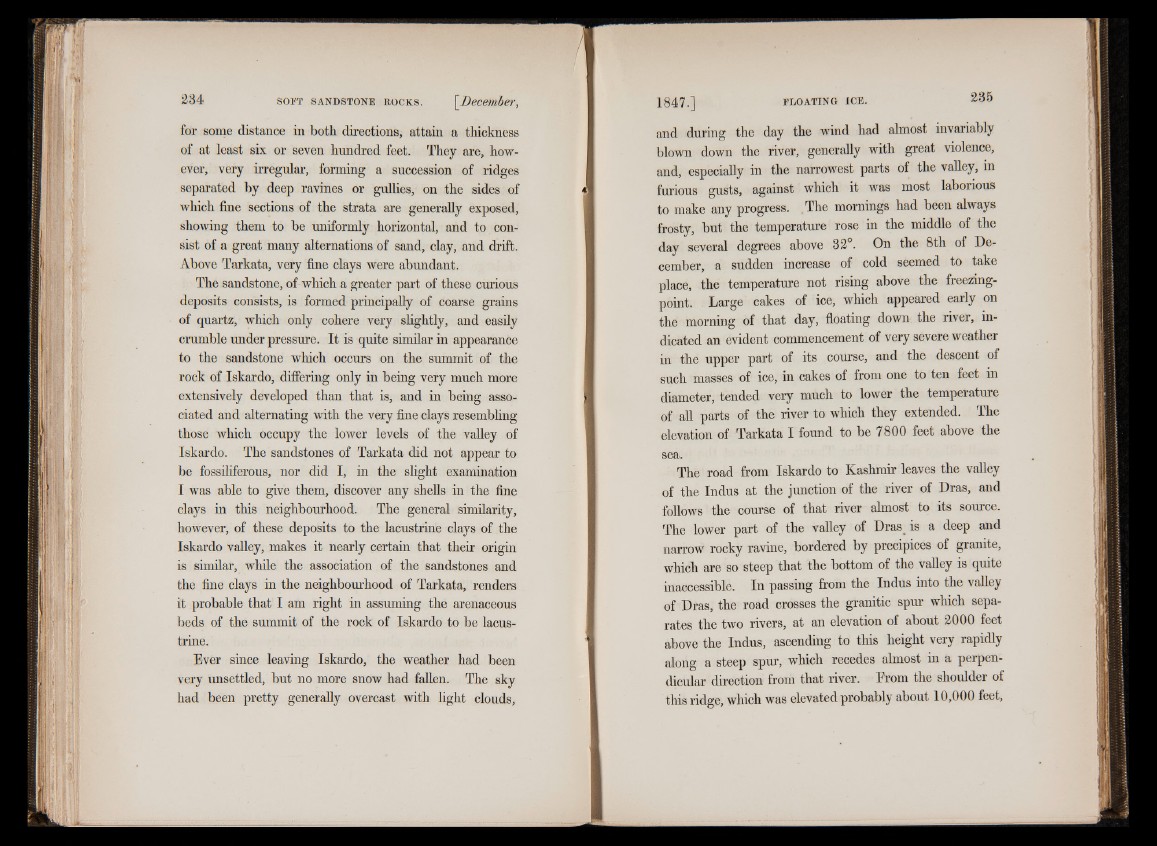
for some distance in both directions, attain a thickness
of at least six or seven hundred feet. They are, however,
very irregular, forming a succession of ridges
separated by deep ravines or gullies, on the sides of
which fine sections of the strata are generally exposed,
showing them to be uniformly horizontal, and to consist
of a great many alternations of sand, clay, and drift.
Above Tarkata, very fine clays were abundant.
The sandstone, of which a greater part of these curious
deposits consists, is formed principally of coarse grains
of quartz, which only cohere very slightly, and easily
crumble under pressure. It is quite similar in appearance
to the sandstone which occurs on the summit of the
rock of Iskardo, differing only in being very much more
extensively developed than that is, and in being associated
and alternating with the very fine clays resembling
those which occupy the lower levels of the valley of
Iskardo. The sandstones of Tarkata did not appear to
be fossiliferous, nor did I, in the slight examination
I was able to give them, discover any shells in the fine
clays in this neighbourhood. The general similarity,
however, of these deposits to the lacustrine clays of the
Iskardo valley, makes it nearly certain that their origin
is similar, while the association of the sandstones and
the fine clays in the neighbourhood of Tarkata, renders
it probable that I am right in assuming the arenaceous
beds of the summit of the rock of Iskardo to be lacustrine.
Ever since leaving Iskardo, the weather had been
very unsettled, but no more snow had fallen. The sky
had been pretty generally overcast with light clouds,
and during the day the wind had almost invariably
blown down the river, generally with great violence,
and, especially in the narrowest parts of the valley, in
furious gusts, against which it was most laborious
to make any progress. The mornings had been always
frosty, but the temperature rose in the middle of the
day several degrees above 32°. On the 8th of December,
a sudden increase of cold seemed to take
place, the temperature not rising above the freezing-
point. Large cakes of ice, which appeared early on
the morning of that day, floating down the river, indicated
an evident commencement of very severe weather
in the upper part of its course, and the descent of
such masses of ice, in cakes of from one to ten feet in
diameter, tended very much to lower the temperature
of all parts of the river to which they extended. The
elevation of Tarkata I found to be 7800 feet above the
sea.
The road from Iskardo to Kashmir leaves the valley
of the Indus at the junction of the river of Dras, and
follows the course of that river almost to its source.
The lower part of the valley of Dras^ is a deep and
narrow rocky ravine, bordered by precipices of granite,
which are so steep that the bottom of the valley is quite
inaccessible. In passing from the Indus into the valley
of Dras, the road crosses the granitic spur which separates
the two rivers, at an elevation of about 2000 feet
above the Indus, ascending to this height very rapidly
along a steep spur, which recedes almost in a perpendicular
direction from that river. From the shoulder of
this ridge, which was elevated probably about 10,000 feet,